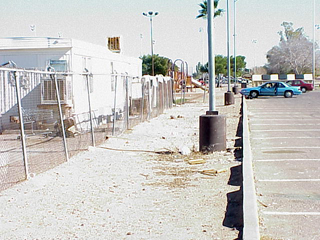![]()
Mike Brown
Freeze-Frame at Hayden Park
Hayden Park was an interesting place for a Freeze-Frame assignment. For those who have not
heard of a Freeze-Frame, it is simply sitting in one spot for 15 to 20 minutes observing ones surroundings. So to continue, at first glance, Hayden Park is a typical Valley of the Sun type park. Most of these typical parks have grass, picnic tables, some trees, and usually some sort of sports availability such as a basketball court or soccer field, or both. In addition, the parks also have pleasant surroundings. But Hayden Park is located in South Phoenix, so automatically the typical standard for parks is altered.

The surroundings around Hayden Park are far from what most people would consider to be pleasant. From the picnic table where I conducted my Freeze-Frame in Hayden Park I could see a junk yard with hundreds of old cars, a cement plant with loud trucks driving around the noisy machines, and a used car lot with a lot of obnoxious advertising, most of which is in Spanish. There was also a fenced in trailer park and some miscellaneous houses; including one that had a cow walking on their front porch and throughout the yard.
As for as people in the park, I was there during the middle of a school day and there were not many people there. There was one peculiar individual, a young Hispanic male, who I observed riding a bicycle in circles around the only building in the park for approximately ten minutes. Nothing but circles, and then he rode off down the road. There was another Hispanic male who was pushing a young child on a swing. After a short time they left the park on foot. The last person I saw during the Freeze-Frame, besides the ice-cream man who drove by and the trailer park resident who passed through the park and walked on down the road, was a city worker who was doing routine maintenance in the park; checking sprinklers, emptying garbage, and doing whatever in the building.

As far as structures go, there was the one small square one-story building with graffiti and the
brick and cement graffiti riddled canopy structures that covered approximately ten picnic tables. Graffiti was basically everywhere, yet I noticed that the Virgin of Guadalupe, the Saint of Mexico, painted on the side of the building was untouched. Not even gang sign graffiti was anywhere near it. This in itself shows respect; which makes me wonder why the youth and various residents of South Phoenix would disrespect the rest of their neighborhood by polluting it in so many ways. Perhaps it is like Tricia Rose stated, “graffiti writers…claim turf and gain local status by developing new styles” (1) Everything else from the cement to the garbage cans to the trees had all types of graffiti present: some spray-paint, some magic markers, and even burnings that removed paint. In addition, the basketball court had paint, burns, and was littered with broken glass, but on a positive note the basketball nylon nets were still intact. Plus while there was miscellaneous broken glass here and there, it was not so excessive that one would harm themselves, if they were careful. Further more, the grass and trees seemed healthy.So overall, while there was a lot of graffiti, it was obvious that there had been attempts to cover it up. Also the park receives regular maintenance. And, while the park was partially surrounded by a noisy cement factory and a junk yard, the residents I observed around the park seemed to enjoy it being there. To conclude, my Freeze-Frame assignment showed me that Hayden Park provides ample opportunity to enjoy the Valley of the Sun and South Phoenix. Finally, doing a Freeze-Frame was intriguing experience and is a good way to gather sociological information. In addition, it showed me that Hayden Park is a good representation of the struggle between the subcultures creating the graffiti trying to gain status and the city’s attempt to suppress it.
References:
1. Rose, Tricia. A Style Nobody Can Deal With. Politics, Style, and Postindustrial City in Hip Hop, chapter twenty six, page 435. Published by, University of Minnesota Press.